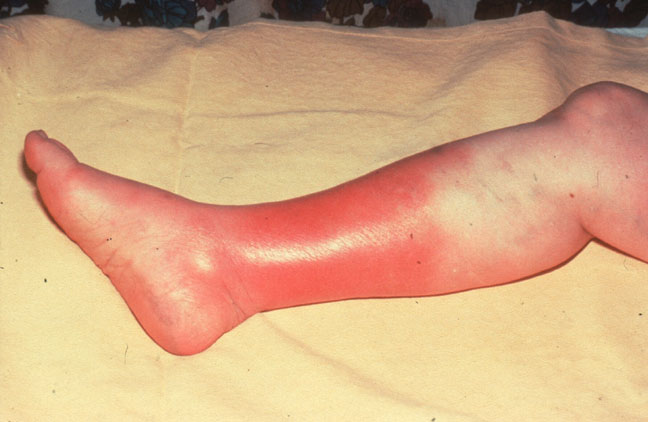

CELLULITIS
 |
 |
Introduction
Maya never expected her friend's cat to bite her. The cat had purred so nicely at first, so Maya was pretty startled when the cat sank its teeth into her leg. Maya washed the bite area right away, and it didn't hurt that much. In fact, Maya had all but forgotten about it by the time it started becoming red and swollen the next day. Her mother took her to the doctor, who announced that Maya had developed cellulitis.
What Is Cellulitis?
The word cellulitis (pronounced: sel-yuh-lye-tus) literally means inflammation of the cells. It is a skin infection that involves areas of tissue just below the surface of the skin. Cellulitis can affect any area of the body, but it's most common on the face or lower legs. Cellulitis can be caused by many different types of bacteria. The most common ones are Group A streptococcus and Staphylococcus aureus.
Cellulitis usually begins in an area of broken skin - like a cut, bite, or scratch. People who have body piercings may actually be more susceptible to cellulitis because the hole where the skin is pierced provides an area for bacteria to get beneath the surface of the skin more easily.
But cellulitis may also start in areas where the skin hasn't been broken, especially in people who have chronic conditions such as diabetes or who are taking medicines that affect the immune system.
What Are the Symptoms of Cellulitis?
Cellulitis begins as a small area of tenderness, swelling, warmth, and redness on the skin. As this area begins to spread, a person who has cellulitis may begin to feel ill and develop a fever and sometimes chills and sweats. Swollen lymph nodes (commonly called swollen glands) are sometimes found near the area of infected skin.
The incubation period (the time it takes for the infection to start causing symptoms) varies, depending on the type of bacteria that causes the cellulitis. For example, cellulitis caused by Pasteurella multocida, the bacteria found in animal bites, has a short incubation period - only 4 to 24 hours after the bite has occurred. But cellulitis caused by other types of bacteria may have an incubation period of several days.
Can I Prevent It?
The only way to prevent cellulitis is by protecting the skin from cuts, bruises, and scrapes. This isn't easy, especially if someone is active or likes to play sports. But there are things you can do to protect yourself. Use elbow and knee pads while skating; wear a bike helmet when you're riding; put on shin guards during soccer; wear long pants and long-sleeved shirts while hiking in the woods (this can also protect you from insect bites and stings); and wear sandals on the beach.
If you do get a scrape, wash the wound well with soap and water. Apply an antibiotic ointment and cover the wound with an adhesive bandage or gauze. For the first few days, check any wound regularly, to see if any of the signs of cellulitis are developing. Pay attention to new piercings, too. If they become red, swollen, and painful to the touch, have them checked out by a doctor.
Cellulitis is not contagious - you can't spread it to another person or catch it from someone else.
Should I Call My Doctor?
Call your doctor whenever any area of your skin becomes red, warm, and painful - with or without fever and chills. This is especially important if the area of skin is on the hands, feet, or face (particularly ear, nose, or eyebrow piercings) or if you have an illness or condition that suppresses the immune system.
Check with your doctor if you get a large cut or a deep puncture wound. Because cellulitis can happen quickly after an animal bite, call your doctor if you've been bitten, especially if the puncture wound is deep. Not too many people get bitten by other people, of course, but human bites can cause dangerous skin infections, too!
How Is Cellulitis Treated?
A doctor can usually diagnose cellulitis by examining the area of affected skin. Sometimes the doctor may check for bacteria by taking blood samples, too. Positive blood cultures mean that bacteria from your skin infection have spread into the bloodstream, which may cause septicemia (blood poisoning), a serious infection.
If you have a mild case of cellulitis, your doctor will probably prescribe antibiotics; these can usually cure cellulitis in 7 to 10 days. (Even if you feel better faster than that, it's important to take all of the antibiotics that a doctor prescribes for you, otherwise the infection can return.) You'll need a follow-up visit with the doctor to make sure that your symptoms are improving. People with severe cases of cellulitis may need to be treated in the hospital with intravenous (IV) antibiotics.
What Can I Do to Make Myself Feel Better?
When treating cellulitis at home, take the antibiotics prescribed by the doctor exactly as directed and for the full course. Follow your doctor's suggestions for treating the area of cellulitis - such as elevating the affected part of your body or applying heat or warm soaks to the affected area.
After you've taken antibiotics for 1 or 2 days, your doctor may schedule an office visit to check that the area of cellulitis has improved, which indicates that the antibiotics are working against the infection.
Disclaimer: This information is not intended be a substitute for professional medical advice. It is provided for educational purposes only. You assume full responsibility for how you choose to use this information.
Reviewed by: Joel Klein, MD
Date reviewed: September 2004